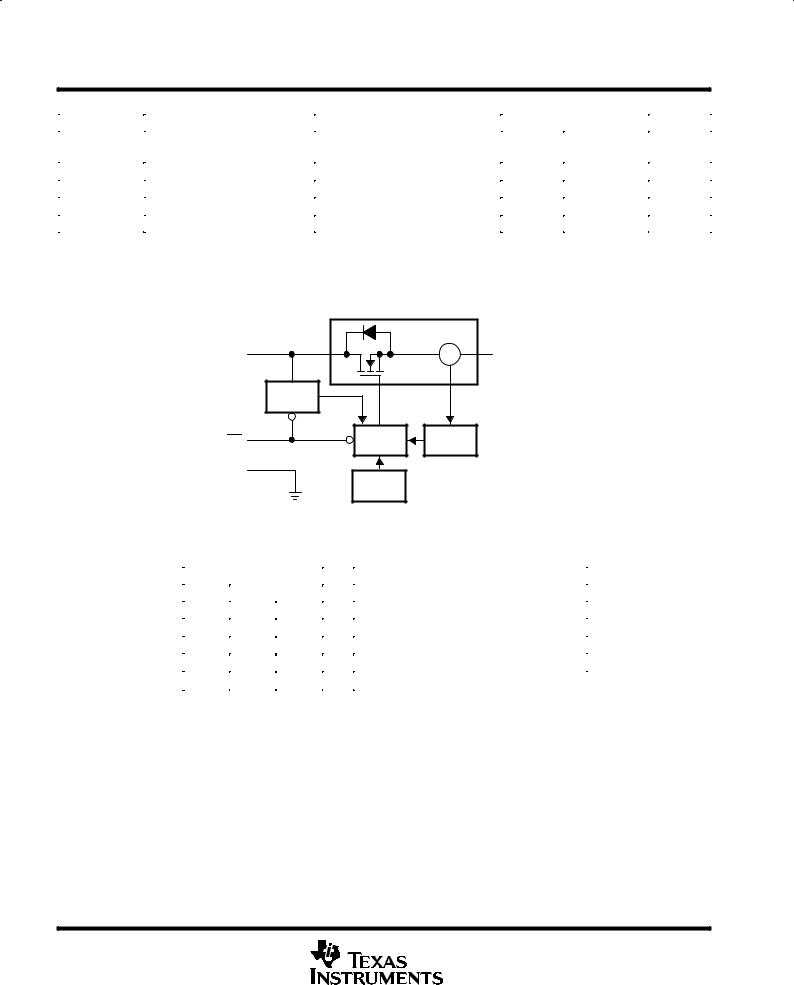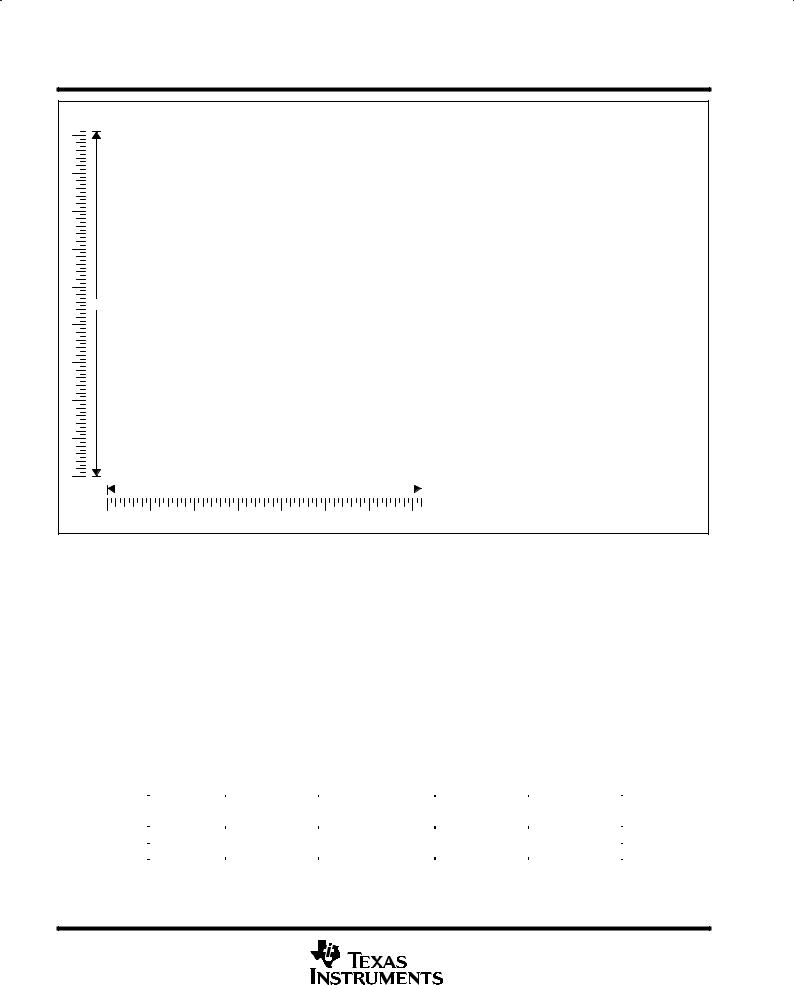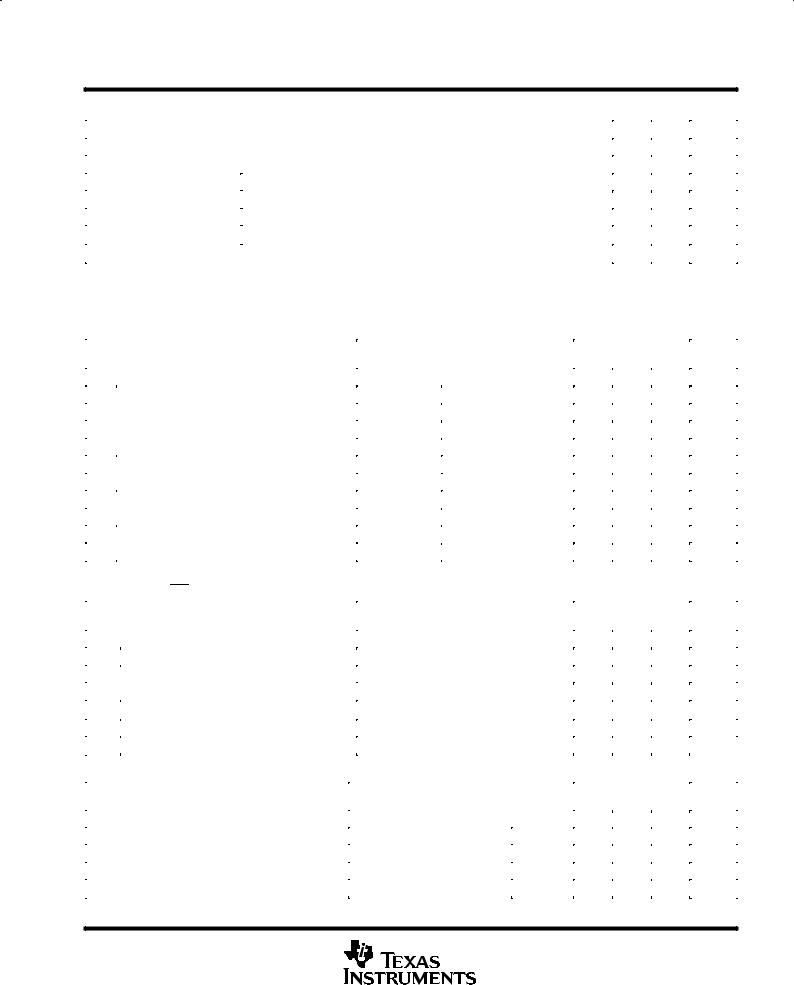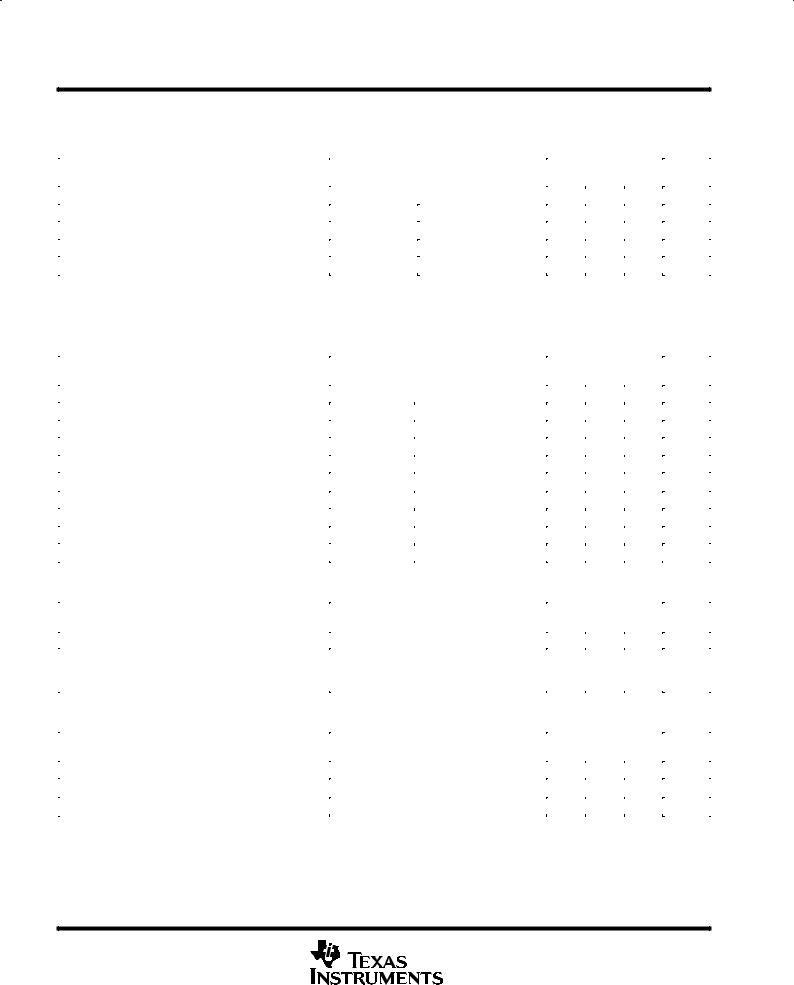Texas Instruments TPS2010D, TPS2012PWLE, TPS2012PWR, TPS2012DR, TPS2012D Datasheet
...
TPS2010, TPS2011, TPS2012, TPS2013
POWER-DISTRIBUTION
SLVS097A ± DECEMBER 1994 ± REVISED AUGUST 1995
D 95-mΩ Max (5.5-V Input) High-Side MOSFET |
|
|
|
|
|
|
D PACKAGE |
|
|||
Switch With Logic Compatible Enable Input |
|
|
|
|
|
|
|
(TOP VIEW) |
|
||
D Short-Circuit and Thermal Protection |
GND |
|
|
|
|
|
OUT |
||||
|
|
1 |
8 |
||||||||
|
|
||||||||||
D Typical Short-Circuit Current Limits: |
|
|
|||||||||
|
|
IN |
|
|
2 |
7 |
OUT |
||||
|
|
|
|||||||||
0.4 A, TPS2010; 1.2 A, TPS2011; |
|
|
IN |
|
|
3 |
6 |
OUT |
|||
|
|
|
|||||||||
2 A, TPS2012; 2.6 A, TPS2013 |
|
|
|
|
|
|
|
|
|
|
|
EN |
|
|
4 |
5 |
OUT |
||||||
D Electrostatic-Discharge Protection, 12-kV |
|
|
|
|
|
|
|
|
|
|
|
|
|
|
|
|
|
|
|
|
|
|
|
|
|
|
|
|
|
|
|
|
|
|
|
Output, 6-kV All Other Terminals |
|
|
|
|
|
|
PW PACKAGE |
||||
|
|
|
|
|
|
|
|||||
D Controlled Rise and Fall Times to Limit |
|
|
|
|
|
|
|
|
(TOP VIEW) |
|
|
Current Surges and Minimize EMI |
GND |
|
|
|
|
|
OUT |
||||
|
|
|
1 |
14 |
|||||||
D SOIC-8 Package Pin Compatible With the |
|
|
|
||||||||
|
|
IN |
|
|
|
OUT |
|||||
Popular Littlefoot Series When GND Is |
|
|
|
|
|
2 |
13 |
||||
|
|
IN |
|
|
|
OUT |
|||||
Connected |
|
|
|
|
|
3 |
12 |
||||
|
|
IN |
|
|
|
4 |
11 |
OUT |
|||
D 2.7-V to 5.5-V Operating Range |
|
|
|
|
|
||||||
|
|
IN |
|
|
|
5 |
10 |
OUT |
|||
|
|
|
|
|
|||||||
D 10-µA Maximum Standby Current |
|
|
|
|
|
||||||
|
|
IN |
|
|
|
6 |
9 |
OUT |
|||
|
|
|
|
|
|||||||
D Surface-Mount SOIC-8 and TSSOP-14 |
|
|
|
|
|
||||||
|
|
|
|
|
|
|
|
|
|
OUT |
|
|
|
EN |
|
|
|
|
7 |
8 |
|||
Packages |
|
|
|
|
|
|
|
|
|
|
|
|
|
|
|
|
|
|
|
|
|
|
|
D ±40°C to 125°C Operating Junction |
|
|
|
|
|
|
|
|
|
|
|
Temperature Range |
|
|
|
|
|
|
|
|
|
|
|
description
The TPS201x family of power-distribution switches is intended for applications where heavy capacitive loads and short circuits are likely to be encountered. The high-side switch is a 95-mΩ N-channel MOSFET. Gate drive is provided by an internal driver and charge pump designed to control the power switch rise times and fall times to minimize current surges during switching. The charge pump operates at 100 kHz, requires no external components, and allows operation from supplies as low as 2.7 V. When the output load exceeds the current-limit threshold or a short circuit is present, the TPS201x limits the output current to a safe level by switching into a constant-current mode. Continuous heavy overloads and short circuits increase power dissipation in the switch and cause the junction temperature to rise. If the junction temperature reaches approximately 180°C, a thermal protection circuit shuts the switch off to prevent damage. Recovery from thermal shutdown is automatic once the device has cooled sufficiently.
The members of the TPS201x family differ only in short-circuit current threshold. The TPS2010 is designed to limit at 0.4-A load; the other members of the family limit at 1.2 A, 2 A, and 2.6 A (see the available options table). The TPS201x family is available in 8-pin small-outline integrated circuit (SOIC) and 14-pin thin shink small-outline (TSSOP) packages and operates over a junction temperature range of ±40°C to 125°C. Versions in the 8-pin SOIC package are drop-in replacements for Siliconix's Littlefoot power PMOS switches, except that GND must be connected.
Please be aware that an important notice concerning availability, standard warranty, and use in critical applications of Texas Instruments semiconductor products and disclaimers thereto appears at the end of this data sheet.
PRODUCTION DATA information is current as of publication date. Products conform to specifications per the terms of Texas Instruments standard warranty. Production processing does not necessarily include testing of all parameters.
Copyright 1995, Texas Instruments Incorporated
POST OFFICE BOX 655303 •DALLAS, TEXAS 75265 |
1 |

TPS2010, TPS2011, TPS2012, TPS2013
POWER-DISTRIBUTION
SLVS097A ± DECEMBER 1994 ± REVISED AUGUST 1995
AVAILABLE OPTIONS
|
RECOMMENDED MAXIMUM |
TYPICAL SHORT-CIRCUIT |
PACKAGED DEVICES |
CHIP |
||
TJ |
CONTINUOUS LOAD CURRENT |
OUTPUT CURRENT LIMIT AT 25°C |
SOIC |
TSSOP |
FORM |
|
|
(A) |
(A) |
(D)² |
(PW)³ |
(Y) |
|
|
0.2 |
0.4 |
TPS2010D |
TPS2010PWLE |
TPS2010Y |
|
|
|
|
|
|
|
|
±40°C to 125°C |
0.6 |
1.2 |
TPS2011D |
TPS2011PWLE |
TPS2011Y |
|
|
|
|
|
|
||
1 |
2 |
TPS2012D |
TPS2012PWLE |
TPS2012Y |
||
|
||||||
|
|
|
|
|
|
|
|
1.5 |
2.6 |
TPS2013D |
TPS2013PWLE |
TPS2013Y |
|
² The D package is available taped and reeled. Add an R suffix to device type (e.g., TPS2010DR).
³ The PW package is only available left-end taped and reeled (indicated by the LE suffix on the device type; e.g., TPS2010PWLE).
functional block diagram
|
Power Switch |
|
IN |
CS ² |
OUT |
Charge |
Pump |
EN |
Driver |
GND |
Thermal |
|
|
|
Sense |
² Current sense |
|
Current |
Limit |
Terminal Functions
|
|
|
TERMINAL |
|
|
|
|
|
|
|
|
|
|
|
|
|
NAME |
|
NO. |
|
I/O |
DESCRIPTION |
|
|
|
D |
PW |
|
|
||
|
|
|
|
|
|
||
|
|
|
|
|
|
|
|
|
|
|
|
4 |
7 |
I |
Enable input. Logic low turns power switch on. |
|
EN |
|
|
||||
|
|
|
|
|
|
|
|
|
GND |
|
1 |
1 |
I |
Ground |
|
|
|
|
|
|
|
|
|
|
IN |
|
2, 3 |
2 ± 6 |
I |
Input voltage |
|
|
|
|
|
|
|
|
|
|
OUT |
|
5 ± 8 |
8 ± 14 |
O |
Power-switch output |
|
|
|
|
|
|
|
|
|
detailed description
power switch
The power switch is an N-channel MOSFET with a maximum on-state resistance of 95 mΩ (VI(IN) = 5.5 V), configured as a high-side switch.
charge pump
An internal 100-kHz charge pump supplies power to the driver circuit and provides the necessary voltage to pull the gate of the MOSFET above the source. The charge pump operates from input voltages as low as 2.7 V and requires very little supply current.
2 |
POST OFFICE BOX 655303 •DALLAS, TEXAS 75265 |

TPS2010, TPS2011, TPS2012, TPS2013
POWER-DISTRIBUTION
SLVS097A ± DECEMBER 1994 ± REVISED AUGUST 1995
detailed description (continued)
driver
The driver controls the gate voltage of the power switch. To limit large current surges and reduce the associated electromagnetic interference (EMI) produced, the driver incorporates circuitry that controls the rise times and fall times of the output voltage. The rise and fall times are typically in the 2-ms to 4-ms range instead of the microsecond or nanosecond range for a standard FET.
enable (EN)
A logic high on the EN input turns off the power switch and the bias for the charge pump, driver, and other circuitry to reduce the supply current to less than 10 A. A logic zero input restores bias to the drive and control circuits and turns the power on. The enable input is compatible with both TTL and CMOS logic levels.
current sense
A sense FET monitors the current supplied to the load. The sense FET is a much more efficient way to measure current than conventional resistance methods. When an overload or short circuit is encountered, the current-sense circuitry sends a control signal to the driver. The driver in turn reduces the gate voltage and drives the power FET into its linear region, which switches the output into a constant current mode and simply holds the current constant while varying the voltage on the load.
thermal sense
An internal thermal-sense circuit shuts the power switch off when the junction temperature rises to approximately 180°C. Hysteresis is built into the thermal sense, and after the device has cooled approximately 20 degrees, the switch turns back on. The switch continues to cycle off and on until the fault is removed.
TPS201xY chip information
This chip, when properly assembled, displays characteristics similar to the TPS201xC. Thermal compression or ultrasonic bonding may be used on the doped aluminum bonding pads. The chip may be mounted with conductive epoxy or a gold-silicon preform.
POST OFFICE BOX 655303 •DALLAS, TEXAS 75265 |
3 |

TPS2010, TPS2011, TPS2012, TPS2013
POWER-DISTRIBUTION
SLVS097A ± DECEMBER 1994 ± REVISED AUGUST 1995
|
BONDING PAD ASSIGNMENTS |
|
|
|
|
|
|
|
|
|
|
(1) |
(8) |
(7) |
GND |
(1) |
|
(8) |
|
|
OUT |
||
|
|
|
|||||||||
|
|
|
(2) |
|
(7) |
|
|
||||
|
|
|
|
IN |
|
|
|
OUT |
|||
|
|
|
|
|
TPS201xY |
|
|
|
|||
|
|
|
(3) |
(6) |
|||||||
|
|
|
|
|
|
|
|
|
|||
|
|
|
|
IN |
|
|
|
OUT |
|||
|
|
|
|
|
|
|
|
|
|||
|
|
|
(4) |
|
(5) |
|
|||||
|
|
|
|
|
|
|
|
|
OUT |
||
(2) |
|
|
EN |
|
|
|
|||||
|
|
|
|
|
|
|
|||||
|
|
|
|
|
|
|
|||||
|
|
|
|
|
|
|
|
|
|
|
|
|
|
|
|
|
|
|
|
|
|
|
|
81
(3) |
|
|
|
|
|
|
|
|
|
|
CHIP THICKNESS: 15 MILS TYPICAL |
|
|
|
|
|
BONDING PADS: 4 × 4 MILS MINIMUM |
|
|
|
|
|
TJmax = 150°C |
|
|
|
|
|
TOLERANCES ARE ± 10% |
(4) |
(5) |
(6) |
|
ALL DIMENSIONS ARE IN MILS |
|
|
|
|
|
|
|
|
|
|
|
|
|
|
72 |
|
|
|
|
|
|
|
|
|
|
absolute maximum ratings over operating free-air temperature range (unless otherwise noted)²
Input voltage range, VI(IN) (see Note 1) . . . . . . . . . . . . . . . . . . . . . . . . . . . . . . . . . . |
. . . . . . . . . . . . . ±0.3 V to 7 V |
||
Output voltage range, VO (see Note 1) . . . . . . . . . . . . . . . . . . . . . . . . . . . . . . . . . . . |
. . . . ±0.3 V to VI(IN) +0.3 V |
||
Input voltage range, VI at |
EN |
. . . . . . . . . . . . . . . . . . . . . . . . . . . . . . . . . . . . . . . . . . . |
. . . . . . . . . . . . . ±0.3 V to 7 V |
Continuous output current, IO . . . . . . . . . . . . . . . . . . . . . . . . . . . . . . . . . . . . . . . . . . . |
. . . . . . . . . . internally limited |
||
Continuous total power dissipation . . . . . . . . . . . . . . . . . . . . . . . . . . . . . . . . . . . . . |
See Dissipation Rating Table |
||
Operating virtual junction temperature range, TJ . . . . . . . . . . . . . . . . . . . . . . . . . . |
. . . . . . . . . . ±40°C to 125°C |
||
Storage temperature range, Tstg . . . . . . . . . . . . . . . . . . . . . . . . . . . . . . . . . . . . . . . . |
. . . . . . . . . . ±65°C to 150°C |
||
Lead temperature soldering 1,6 mm (1/16 inch) from case for 10 seconds . . . . |
. . . . . . . . . . . . . . . . . . . 260°C |
||
²Stresses beyond those listed under ªabsolute maximum ratingsº may cause permanent damage to the device. These are stress ratings only, and functional operation of the device at these or any other conditions beyond those indicated under ªrecommended operating conditionsº is not
implied. Exposure to absolute-maximum-rated conditions for extended periods may affect device reliability. NOTE 1: All voltages are with respect to GND.
DISSIPATION RATING TABLE
PACKAGE |
TA ≤ 25°C |
DERATING FACTOR |
TA = 70°C |
TA = 125°C |
|
POWER RATING |
ABOVE TA = 25°C |
POWER RATING |
POWER RATING |
||
|
|||||
D |
725 mW |
5.8 mW/°C |
464 mW |
145 mW |
|
PW |
700 mW |
5.6 mW/°C |
448 mW |
140 mW |
|
|
|
|
|
|
4 |
POST OFFICE BOX 655303 •DALLAS, TEXAS 75265 |

TPS2010, TPS2011, TPS2012, TPS2013
POWER-DISTRIBUTION
SLVS097A ± DECEMBER 1994 ± REVISED AUGUST 1995
recommended operating conditions
|
|
|
|
MIN |
MAX |
UNIT |
|
|
|
|
|
|
|
|
|
Input voltage, VI(IN) |
|
2.7 |
5.5 |
V |
|||
Input voltage, VI at |
|
|
|
0 |
5.5 |
V |
|
EN |
|
|
|||||
|
|
|
TPS2010 |
0 |
0.2 |
|
|
|
|
|
|
|
|
|
|
Continuous output current, IO |
TPS2011 |
0 |
0.6 |
A |
|||
|
|
|
|||||
TPS2012 |
0 |
1 |
|||||
|
|
|
|
||||
|
|
|
|
|
|
|
|
|
|
|
TPS2013 |
0 |
1.5 |
|
|
|
|
|
|
|
|||
Operating virtual junction temperature, TJ |
± 40 |
125 |
°C |
||||
electrical characteristics over recommended operating junction temperature range, VI(IN) = 5.5 V, IO = rated current, EN = 0 V (unless otherwise noted)
power switch
|
|
|
|
|
|
|
TPS2010, TPS2011 |
|
|
|
PARAMETER |
|
|
TEST CONDITIONS² |
|
TPS2012, TPS2013 |
UNIT |
||
|
|
|
|
|
|
|
MIN TYP |
MAX |
|
|
|
|
|
|
|
|
|
|
|
|
|
|
VI(IN) = 5.5 V, |
TJ = 25°C |
|
75 |
95 |
|
|
|
On-state resistance |
|
VI(IN) = 4.5 V, |
TJ = 25°C |
|
80 |
110 |
mΩ |
|
|
|
VI(IN) = 3 V, |
TJ = 25°C |
|
120 |
175 |
|||
|
|
|
|
|
|||||
|
|
|
VI(IN) = 2.7 V, |
TJ = 25°C |
|
140 |
215 |
|
|
|
Output leakage current |
|
|
= VI(IN) |
TJ = 25°C |
|
0.001 |
1 |
A |
|
|
EN |
|
|
|
|
|||
|
|
± 40°C ≤ TJ ≤ 125°C |
|
10 |
|||||
|
|
|
|
|
|
|
|||
tr |
Output rise time |
|
VI(IN) = 5.5 V, |
TJ = 25°C, |
CL = 1 F |
4 |
|
ms |
|
|
VI(IN) = 2.7 V, |
TJ = 25°C, |
CL = 1 F |
3.8 |
|
||||
|
|
|
|
|
|||||
tf |
Output fall time |
|
VI(IN) = 5.5 V, |
TJ = 25°C, |
CL = 1 F |
3.9 |
|
ms |
|
|
VI(IN) = 2.7 V, |
TJ = 25°C, |
CL = 1 F |
3.5 |
|
||||
|
|
|
|
|
|||||
² Pulse-testing techniques maintain junction temperature close to ambient temperature; thermal effects must be taken into account separately.
enable input (EN)
|
|
|
|
|
|
|
TPS2010, TPS2011 |
|
|
|
PARAMETER |
|
TEST CONDITIONS |
TPS2012, TPS2013 |
UNIT |
||||
|
|
|
|
||||||
|
|
|
|
|
|
|
MIN |
TYP MAX |
|
|
|
|
|
|
|
|
|
|
|
|
High-level input voltage |
|
2.7 V ≤ VI(IN) ≤ 5.5 V |
2 |
|
V |
|||
|
Low-level input voltage |
|
4.5 V ≤ VI(IN) ≤ 5.5 V |
|
0.8 |
V |
|||
|
|
2.7 V ≤ VI(IN) < 4.5 V |
|
0.4 |
|||||
|
|
|
|
|
|||||
|
Input current |
|
|
= 0 V or |
|
= VI(IN) |
± 0.5 |
0.5 |
A |
|
|
EN |
EN |
||||||
tPLH |
Propagation (delay) time, low-to-high-level output |
|
CL = 1 F |
|
20 |
ms |
|||
tPHL |
Propagation (delay) time, high-to-low-level output |
|
CL = 1 F |
|
40 |
||||
|
|
|
|||||||
current limit
|
|
|
TPS2010, TPS2011 |
|
|||
PARAMETER |
TEST CONDITIONS² |
|
TPS2012, TPS2013 |
UNIT |
|||
|
|
|
MIN |
TYP |
MAX |
|
|
|
|
|
|
|
|
|
|
|
TJ = 25°C, |
TPS2010 |
0.22 |
0.4 |
0.6 |
|
|
|
|
|
|
|
|
||
|
TPS2011 |
0.66 |
1.2 |
1.8 |
|
||
Short-circuit current |
VI(IN) = 5.5 V, |
A |
|||||
OUT connected to GND, device |
TPS2012 |
1.1 |
2 |
3 |
|||
|
|
||||||
|
enabled into short circuit |
|
|
|
|
|
|
|
TPS2013 |
1.65 |
2.6 |
4.5 |
|
||
|
|
|
|||||
|
|
|
|
|
|
|
|
² Pulse-testing techniques maintain junction temperature close to ambient temperature; thermal effects must be taken into account separately.
POST OFFICE BOX 655303 •DALLAS, TEXAS 75265 |
5 |

TPS2010, TPS2011, TPS2012, TPS2013
POWER-DISTRIBUTION
SLVS097A ± DECEMBER 1994 ± REVISED AUGUST 1995
electrical characteristics over recommended operating junction temperature range, VI(IN) = 5.5 V, IO = rated current, EN = 0 V (unless otherwise noted) (continued)
supply current
|
|
|
|
|
|
|
TPS2010, TPS2011 |
|
||
PARAMETER |
|
|
|
TEST CONDITIONS |
|
TPS2012, TPS2013 |
UNIT |
|||
|
|
|
|
|
|
|
||||
|
|
|
|
|
|
|
MIN |
TYP |
MAX |
|
|
|
|
|
|
|
|
|
|
|
|
Supply current, low-level output |
|
|
= VI(IN) |
|
TJ = 25°C |
|
|
0.015 |
1 |
A |
|
EN |
|
|
|
|
|
|
|||
|
|
± 40°C ≤ TJ |
≤ 125°C |
|
|
10 |
||||
|
|
|
|
|
|
|
|
|||
|
|
|
|
|
TJ = 25°C |
|
|
73 |
100 |
A |
Supply current, high-level output |
|
EN = 0 V |
|
|
|
|||||
|
|
± 40°C ≤ TJ |
≤ 125°C |
|
|
100 |
||||
|
|
|
|
|
|
|
|
|||
electrical characteristics over recommended operating junction temperature range, VI(IN) = 5.5 V, IO = rated current, EN = 0 V, TJ = 25°C (unless otherwise noted)
power switch
|
|
|
|
|
TPS2010Y, TPS2011Y |
|
PARAMETER |
|
|
TEST CONDITIONS² |
TPS2012Y, TPS2013Y |
UNIT |
|
|
|
|
|
|
MIN TYP MAX |
|
|
|
|
|
|
|
|
|
|
VI(IN) = 5.5 V, |
|
75 |
|
|
On-state resistance |
|
VI(IN) = 4.5 V, |
|
80 |
mΩ |
|
|
VI(IN) = 3 V, |
|
120 |
|||
|
|
|
|
|||
|
|
VI(IN) = 2.7 V, |
|
140 |
|
|
Output leakage current |
|
|
= VI(IN) |
|
0.001 |
A |
|
EN |
|
||||
Output rise time |
|
VI(IN) = 5.5 V, |
CL = 1 F |
4 |
ms |
|
|
VI(IN) = 2.7 V, |
CL = 1 F |
3.8 |
|||
|
|
|
||||
Output fall time |
|
VI(IN) = 5.5 V, |
CL = 1 F |
3.9 |
ms |
|
|
VI(IN) = 2.7 V, |
CL = 1 F |
3.5 |
|||
|
|
|
||||
² Pulse-testing techniques maintain junction temperature close to ambient temperature; thermal effects must be taken into account separately.
current limit
|
|
TPS2010Y, TPS2011Y |
|
PARAMETER |
TEST CONDITIONS² |
TPS2012Y, TPS2013Y |
UNIT |
|
|
MIN TYP MAX |
|
|
|
|
|
|
VI(IN) = 5.5 V, |
|
|
Short-circuit current |
OUT connected to GND, |
0.4 |
A |
|
Device enabled into short circuit |
|
|
² Pulse-testing techniques maintain junction temperature close to ambient temperature; thermal effects must be taken into account separately.
supply current
|
|
|
|
|
TPS2010Y, TPS2011Y |
|
||
PARAMETER |
|
|
|
TEST CONDITIONS |
TPS2012Y, TPS2013Y |
UNIT |
||
|
|
|
|
|
|
|||
|
|
|
|
|
MIN |
TYP |
MAX |
|
|
|
|
|
|
|
|
|
|
Supply current, low-level output |
|
|
|
= VI(IN) |
|
0.015 |
|
A |
|
EN |
|
|
|
||||
Supply current, high-level output |
|
|
|
= 0 V |
|
73 |
|
A |
|
EN |
|
|
|||||
6 |
POST OFFICE BOX 655303 •DALLAS, TEXAS 75265 |
